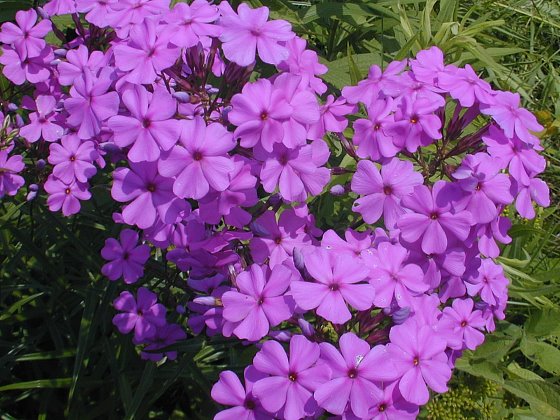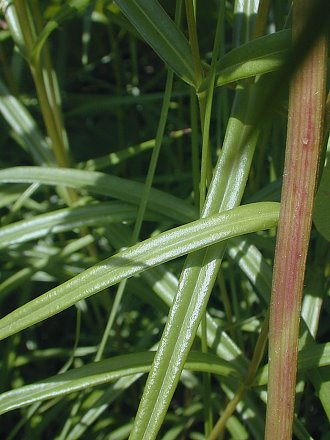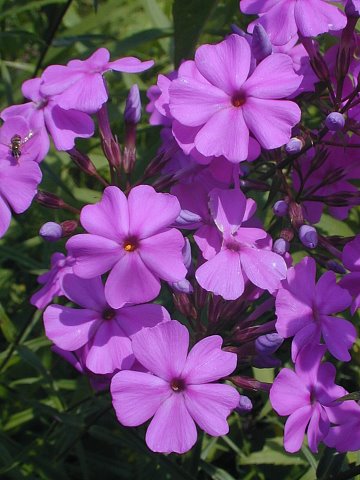Description: This perennial wildflower is 1¼–2½' tall. It is unbranched, unless the central stem is broken off, in which case 2-3 lateral stems will develop. The central stem is green, slender, and hairless – it is without purple streaks or spots. The opposite leaves are medium green, linear-lanceolate to linear in shape, smooth (entire) along their margins, and hairless. Each leaf has a prominent central vein. The lower leaves are either sessile or they clasp the stem, while the upper leaves are sessile.

At the apex of the
central stem, there occurs a
small cluster of 3-20 flowers with pink or lavender corollas.
The flower cluster is slightly dome-shaped, rather than
flat-topped or elongated. Individual flowers are about ¾" across or
slightly larger. Each flower has 5 petal-like lobes that
spread
outward from the throat of a corolla that is narrowly tubular below.
These lobes are obovate to obcordate in shape with either rounded or
slightly notched tips.
The calyx is deeply divided into 5 slender lobes that are
linear to linear-lanceolate; it is green to purple and hairless. The
calyx is
shorter than the tubular base of the corolla. The reproductive organs
are inserted within the corolla and inconspicuous. The flowers are
fragrant. The blooming
period can occur from late spring to late summer, lasting about 1-2
months. The flowers are replaced by narrow seed capsules; each capsule
contains many small seeds. The root system consists of a taproot. This
plant spreads by
reseeding itself.
Cultivation:
The preferred situation consists of full sun to light shade,
moist conditions, and a fertile loam or sandy loam with decaying
organic material.
Young plants can be killed by summer heat and drought, particularly in
locations that lack adequate moisture. There is a tendency to sprawl,
unless this plant is supported by grass and other kinds of vegetation.
Foliar disease isn't a significant problem.

Range &
Habitat:
The native Smooth Phlox occurs occasionally in the eastern two-thirds
of Illinois, but it is uncommon or absent in western Illinois (see Distribution
Map). Habitats include moist black soil prairies, moist sand
prairies,
cemetery prairies, prairie remnants along railroads, openings in
bottomland woodlands, thickets, acidic gravelly seeps, and abandoned
fields. This is an indicator plant of higher quality prairie remnants –
the showy flowers can be spotted from some distance away, facilitating
the discovery of new sites.
Faunal Associations:
The flowers of Smooth Phlox are visited by butterflies, skippers, and
moths for nectar. Butterfly visitors include Monarchs, Swallowtails,
and Sulfurs. Occasionally, small Syrphid flies may feed on the pollen,
but they are non-pollinating. The larvae of a long-horned beetle, Oberea flavipes,
bore through the stems. The caterpillars of the moth Heliothis
turbatus (Spotted Straw) eat the flowers, while the
caterpillars of the moth Lacinipolia olivacea
(Olive Arches) eat the foliage. Some plant bugs suck on the juices of
the this plant, including Lopidea davisi (Phlox
Scarlet Plant Bug) and Poecilocapsus lineatus
(Four-Lined Plant Bug). Rabbits, groundhogs, deer, and probably other
mammalian herbivores readily consume Smooth Phlox.
Photographic Location:
The photographs were taken at a moist prairie remnant along an
abandoned railroad in Champaign County, Illinois.

Comments: This plant has attractive foliage and flowers. Some authors from the eastern coast of the United States report the size of Smooth Phlox as up to 4-5' tall, but such huge plants apparently don't occur in Illinois. Smooth Phlox resembles Phlox pilosa (Prairie Phlox), except the latter species typically has hairy stems and calyces, and it tends to be shorter and blooms earlier. Smooth Phlox even more closely resembles the hairless Phlox pilosa sangamonensis (Sangamon Phlox), but the petal-like lobes of the latter species are less rounded and more angular (rhombic) in shape, while the bases of its petal-like lobes are more narrow and wedge-shaped. Another similar species, Phlox maculata (Meadow Phlox), has stems with purple spots or streaks, wider leaves, and a more elongated inflorescence. Smooth Phlox can be rather variable across different populations, possibly because of some hybridization with other Phlox spp. If a site is sufficiently moist, both Smooth Phlox and Meadow Phlox are found occasionally with Prairie Phlox.